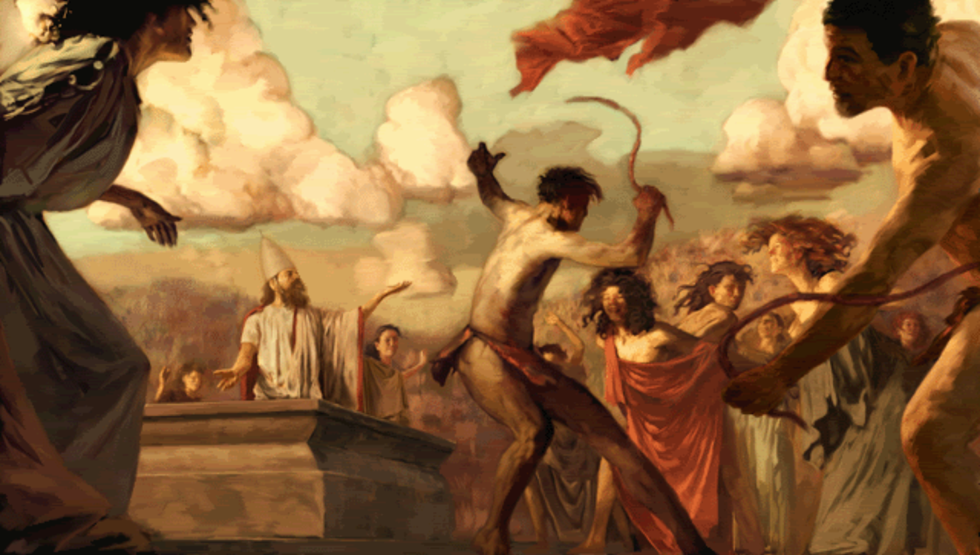It's no secret that just about everything the ancient Romans did was to relinquish evil spirits. In doing so, the Romans themselves may have been nothing short of the negativity they were trying to eliminate.
With the founding of Rome came the founding of Lupercalia-- a sacrificial and ultimately horrifying feast that lasted from February 13 to February 15. The beginning was marked with the sacrifice of a goat and dog (yes, a dog). After the animals were sacrificed, their blood was smeared on the foreheads of naked men who would then use the skins as whips to beat any woman that neared them.
If your brow isn't furrowed yet, it will be soon.
You may think women dreaded this practice, but they actually would line up to be thrashed. Speculation as to why still reels the heads of historians to this date, but a more popular theory is the belief that being whipped with the sacrificed skins would strengthen fertility. Because goats were a symbol of sexuality and the act was a metaphor for penetration, married men would even subject their wives to this practice.
As drunk and sadistic as Romans were, they certainly had their reasons.
As the centuries churned on, the practices became a little less sexual: less nudity and overall sexuality. Women would accept lashings across their hands instead of their bare bodies, and performing men would wear more than just a loincloth. Although sacrifice was prohibited in 341 AD, the ceremony of Lupercalia carried on until the end of the fifth century when Pope Gelasius decided it was no longer being performed correctly (... but was it ever?).
In different years of the third century, two men -- both named Valentine -- were executed under Emperor Claudius II. They were considered martyrs by the Catholic church, who wanted to keep their memories alive -- thus, St. Valentine's Day was born.
In an attempt to whipe out the sacrificial practice, Pope Gelasius combined the feast of Lupercalia with St. Valentine's Day. This didn't stop Romans from trying to celebrate a day of sexuality, although it did change the way they went about it. What was once a sacrificial ceremony turned into more of an entertainment charade.
Over the years, the historic day was carried on by people like Geoffrey Chaucer and William Shakespeare, who romanticized it in their literature. As art modernized and made its way into the Western world, commercialization of Valentine's Day blossomed. A major contribution was the establishment of Hallmark in the nineteenth century. In 1913, they introduced their first Valentine cards.
Hallmark attributes their idea to one of the martyrs:
"One legend involves Valentinus, a theologian and teacher. During the third century, Valentinus was imprisoned for his Christian beliefs and sentenced to death. While jailed, according to Roman legend, Valentinus restored the sight of his jailer’s blind daughter. The night before he died, Valentinus wrote a farewell note to the girl, which he signed, 'From Your Valentine.' His sentence was carried out the next day, Feb. 14, 269 A.D" -Hallmark
So, there you have it. Love it or hate it, the holiday is still thriving to this day. Social media has taken it to a whole different level of commercialization, although it seems many people want to do away with the frilly presents and romantic dinner reservations altogether.
You'll catch a lot of people complaining about the unnecessarily expensive romantic aisles in stores and claiming we should show love year round -- not just limit it to one day.
I personally agree that the cheap trinkets are overpriced and impersonal, but with sexuality being something so publicly confrontational, why not let people enjoy a day out of the year to celebrate how we all got here? (Newsflash: it wasn't the stork). Either way you look at it, the Romans will always be a drunken world of wonder.
Happy Valentine's Day!
















